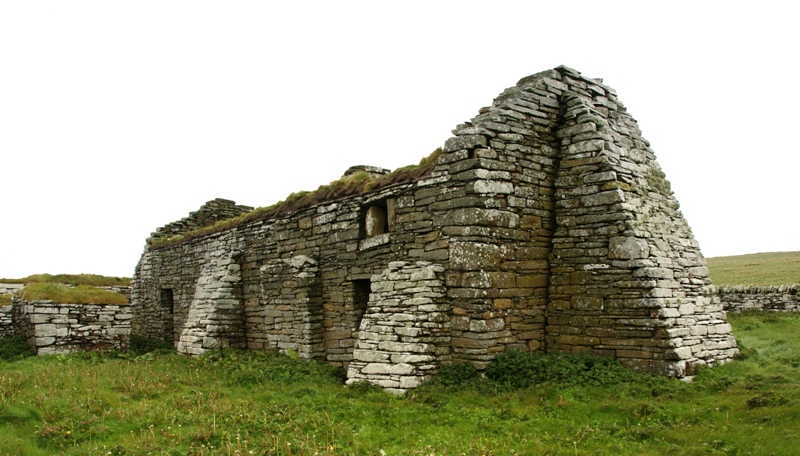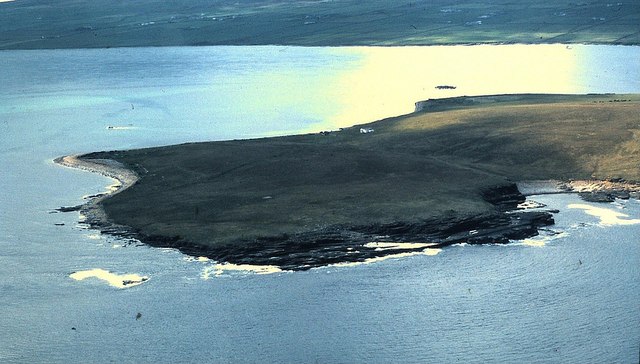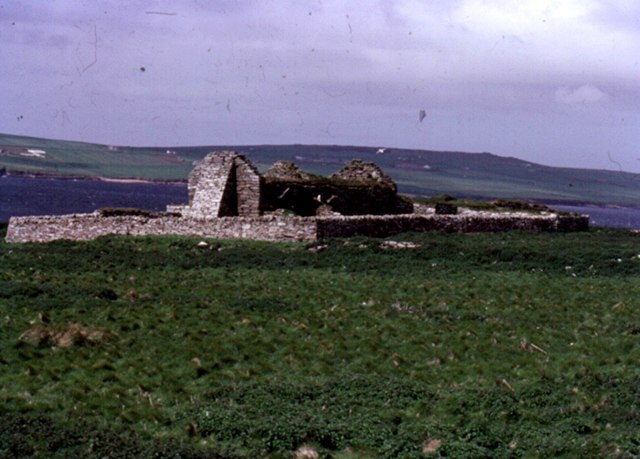|
Eynhallow Church
Eynhallow Church is a ruined medieval church located on the uninhabited island of Eynhallow in Orkney, Scotland. The church dates back to the 12th-century and is thought to have originally been a monastery. Near the church are the building remains from a post-medieval village. Historic Environment Scotland first listed the site as a scheduled monument in 1921. Description The ruins of Eynhallow church are situated on a slope in southwestern Eynhallow, in Orkney, Scotland. The island lies between Rousay and Mainland, Orkney. The site consists of a roofless 12th-century church, measuring by across. The church was later modified and was used as a residential dwelling, beginning in the 16th century. Much of the church's original fabric is still visible. The best surviving features of the church are the walls of the porch, the gables in the nave, and the foundation of the chancel walls. The interior contains a rectangular sized nave with a porch at its west end and a square-ended ... [...More Info...] [...Related Items...] OR: [Wikipedia] [Google] [Baidu] |
Eynhallow Church 20110526 From Southeast
Eynhallow ( sco, Eynhallow; non, Eyinhelga; nrn, Øjinhellig) is a small, presently uninhabited island, part of Orkney, off the north coast of mainland Scotland. Geography Eynhallow lies in Eynhallow Sound between Mainland, Orkney and Rousay. It is in area. An unnamed skerry is situated approximately to the north-east of the island, separated by Fint Sound. Sheep Skerry adjoins the southern end of the island. There is no ferry to the island, although Orkney Heritage Society organises a trip each July. Otherwise, visitors have to arrange their own transport to the island by private local boat hire. Access can be problematic, as there are strong tidal surges in the surrounding strait, squeezed between Mainland of Orkney and Rousay. History The island's main attraction is Eynhallow Church dating from the twelfth century or earlier, and perhaps originally part of a monastery. The site is maintained by Historic Scotland. In 1841 the island had a population of 26. It has been u ... [...More Info...] [...Related Items...] OR: [Wikipedia] [Google] [Baidu] |
Eynhallow Church 20110526 From Northwest
Eynhallow ( sco, Eynhallow; non, Eyinhelga; nrn, Øjinhellig) is a small, presently uninhabited island, part of Orkney, off the north coast of mainland Scotland. Geography Eynhallow lies in Eynhallow Sound between Mainland, Orkney The Mainland, also known as Hrossey and Pomona, is the main island of Orkney, Scotland. Both of Orkney's burghs, Kirkwall and Stromness, lie on the island, which is also the heart of Orkney's ferry and air connections. Seventy-five per cent of ... and Rousay. It is in area. An unnamed skerry is situated approximately to the north-east of the island, separated by Fint Sound. Sheep Skerry adjoins the southern end of the island. There is no ferry to the island, although Orkney Heritage Society organises a trip each July. Otherwise, visitors have to arrange their own transport to the island by private local boat hire. Access can be problematic, as there are strong tidal surges in the surrounding strait, squeezed between Mainland of Orkney and Rou ... [...More Info...] [...Related Items...] OR: [Wikipedia] [Google] [Baidu] |
Church Ruins In Scotland
Church may refer to: Religion * Church (building), a building for Christian religious activities * Church (congregation), a local congregation of a Christian denomination * Church service, a formalized period of Christian communal worship * Christian denomination, a Christian organization with distinct doctrine and practice * Christian Church, either the collective body of all Christian believers, or early Christianity Places United Kingdom * Church (Liverpool ward), a Liverpool City Council ward * Church (Reading ward), a Reading Borough Council ward * Church (Sefton ward), a Metropolitan Borough of Sefton ward * Church, Lancashire, England United States * Church, Iowa, an unincorporated community * Church Lake, a lake in Minnesota Arts, entertainment, and media * '' Church magazine'', a pastoral theology magazine published by the National Pastoral Life Center Fictional entities * Church (''Red vs. Blue''), a fictional character in the video web series ''Red vs. Blue'' * Chur ... [...More Info...] [...Related Items...] OR: [Wikipedia] [Google] [Baidu] |
12th-century Church Buildings In Scotland
1 (one, unit, unity) is a number representing a single or the only entity. 1 is also a numerical digit and represents a single unit of counting or measurement. For example, a line segment of ''unit length'' is a line segment of length 1. In conventions of sign where zero is considered neither positive nor negative, 1 is the first and smallest positive integer. It is also sometimes considered the first of the infinite sequence of natural numbers, followed by 2, although by other definitions 1 is the second natural number, following 0. The fundamental mathematical property of 1 is to be a multiplicative identity, meaning that any number multiplied by 1 equals the same number. Most if not all properties of 1 can be deduced from this. In advanced mathematics, a multiplicative identity is often denoted 1, even if it is not a number. 1 is by convention not considered a prime number; this was not universally accepted until the mid-20th century. Additionally, 1 is the s ... [...More Info...] [...Related Items...] OR: [Wikipedia] [Google] [Baidu] |
Historic Scotland Properties In Orkney
History (derived ) is the systematic study and the documentation of the human activity. The time period of event before the invention of writing systems is considered prehistory. "History" is an umbrella term comprising past events as well as the memory, discovery, collection, organization, presentation, and interpretation of these events. Historians seek knowledge of the past using historical sources such as written documents, oral accounts, art and material artifacts, and ecological markers. History is not complete and still has debatable mysteries. History is also an academic discipline which uses narrative to describe, examine, question, and analyze past events, and investigate their patterns of cause and effect. Historians often debate which narrative best explains an event, as well as the significance of different causes and effects. Historians also debate the nature of history as an end in itself, as well as its usefulness to give perspective on the problems of the p ... [...More Info...] [...Related Items...] OR: [Wikipedia] [Google] [Baidu] |
Ruins In Orkney
Ruins () are the remains of a civilization's architecture. The term refers to formerly intact structures that have fallen into a state of partial or total disrepair over time due to a variety of factors, such as lack of maintenance, deliberate destruction by humans, or uncontrollable destruction by natural phenomena. The most common root causes that yield ruins in their wake are natural disasters, armed conflict, and population decline, with many structures becoming progressively derelict over time due to long-term weathering and scavenging. There are famous ruins all over the world, with notable sites originating from ancient China, the Indus Valley and other regions of ancient India, ancient Iran, ancient Israel and Judea, ancient Iraq, ancient Greece, ancient Egypt, Roman sites throughout the Mediterranean Basin, and Incan and Mayan sites in the Americas. Ruins are of great importance to historians, archaeologists and anthropologists, whether they were once individual fort ... [...More Info...] [...Related Items...] OR: [Wikipedia] [Google] [Baidu] |
Churches In Orkney
Church may refer to: Religion * Church (building), a building for Christian religious activities * Church (congregation), a local congregation of a Christian denomination * Church service, a formalized period of Christian communal worship * Christian denomination, a Christian organization with distinct doctrine and practice * Christian Church, either the collective body of all Christian believers, or early Christianity Places United Kingdom * Church (Liverpool ward), a Liverpool City Council ward * Church (Reading ward), a Reading Borough Council ward * Church (Sefton ward), a Metropolitan Borough of Sefton ward * Church, Lancashire, England United States * Church, Iowa, an unincorporated community * Church Lake, a lake in Minnesota Arts, entertainment, and media * ''Church magazine'', a pastoral theology magazine published by the National Pastoral Life Center Fictional entities * Church (''Red vs. Blue''), a fictional character in the video web series ''Red vs. Blue'' * Churc ... [...More Info...] [...Related Items...] OR: [Wikipedia] [Google] [Baidu] |
Kolbeinn Hrúga
Kolbeinn hrúga was a 12th century Norse chieftain in Orkney. He figures prominently in the Orkneyinga saga. Kolbeinn was born in Sunnfjord, Norway. Around 1145, he arrived in Orkney. Shortly after his arrival, Kolbeinn was responsible for constructing numerous castles on the west side of the island of Wyre, which are some of the oldest of its kind in Orkney. The influence of Kolbeinn is attested by his contribution to elevating Eystein II to King of Norway The Norwegian monarch is the head of state of Norway, which is a constitutional and hereditary monarchy with a parliamentary system. The Norwegian monarchy can trace its line back to the reign of Harald Fairhair and the previous petty kingdoms .... The folkloric giant Cubbie Roo, alleged architect of Cobbie Row's Castle (among other geologic formations), may be named for Kolbeinn hrúga. Sources * Walter Baetke (Hrsg.): Die Geschichten von den Orkaden, Dänemark und der Jomsburg (= Thule. Altnordische Dichtung und ... [...More Info...] [...Related Items...] OR: [Wikipedia] [Google] [Baidu] |
Sweyn Asleifsson
Sweyn Asleifsson or Sveinn Ásleifarson ( 1115 – 1171) was a twelfth-century Viking who appears in the '' Orkneyinga Saga''. Early career Sweyn was born in Caithness in the early twelfth century, to Olaf Hrolfsson and his wife Åsleik. According to the '' Orkneyinga Saga'', he came to prominence when he murdered Earl Paul of Orkney's cup-bearer c. 1134 in a quarrel over a drinking game, and fled to Tiree to take refuge with Holdbodi Hundason.''Orkneyinga Saga'' In 1140, Holdbodi called on Sweyn to join him raiding the coast of Wales, but they were beaten off, Holdbodi withdrawing to the Isle of Man and Sweyn to Lewis. In the early summer of 1141, Sweyn arrived in Man to join Holdbodi, but the Hebridean had been persuaded to join forces with the Norman-Welsh lord Robert who had defeated them in the previous year, and attacked Sweyn. This created a feud between the former friends. Quarrels and feuds Some years later, after falling out with his own captains (led by his brother-i ... [...More Info...] [...Related Items...] OR: [Wikipedia] [Google] [Baidu] |
Shapeshifters
In mythology, folklore and speculative fiction, shape-shifting is the ability to physically transform oneself through an inherently superhuman ability, divine intervention, demonic manipulation, sorcery, spells or having inherited the ability. The idea of shape-shifting is in the oldest forms of totemism and shamanism, as well as the oldest existent literature and epic poems such as the ''Epic of Gilgamesh'' and the ''Iliad''. The concept remains a common literary device in modern fantasy, children's literature and popular culture. Folklore and mythology Popular shape-shifting creatures in folklore are werewolves and vampires (mostly of European, Canadian, and Native American/early American origin), ichchadhari naag and ichchadhari naagin (shape-shifting cobras) of India, the huli jing of East Asia (including the Japanese ''kitsune'' and Korean ''kumiho''), and the gods, goddesses, and demons and demonesses like succubus and incubus and other numerous mythologies, s ... [...More Info...] [...Related Items...] OR: [Wikipedia] [Google] [Baidu] |
Finfolk
In Orkney folklore, Finfolk (sometimes Finnfolk) are Magick shapeshifters of the sea, the dark mysterious race from Finfolkaheem who regularly make an amphibious journey from the depths of the Finfolk ocean home to the Orkney Islands. They wade, swim or sometimes row upon the Orkney shores in the spring and summer months, searching for human captives. The Finfolk (both Finman and Finwife) kidnap unsuspecting fishermen, or frolicking youth, near the shore and force them into lifelong servitude as a spouse. The Finfolk Finman The Finman is described as being tall and thin with a stern, gloomy face. He is said to have many magical powers, such as rowing between Norway and Orkney in seven oar-strokes, making his ship invisible and creating fleets of phantom boats. He avoids human contact, but is extremely territorial and will wreak havoc on the boats of any fishermen trespassing in 'his' waters, though he may sometimes be deterred by drawing a cross on the bottom of a craft with ch ... [...More Info...] [...Related Items...] OR: [Wikipedia] [Google] [Baidu] |




.jpg)

